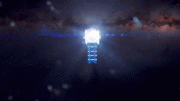
The Thwaites Glacier in Antarctica, undergoing significant ice loss since the 1940s due to climate changes and El Niño events, contributes to 4% of global sea-level rise. Researchers emphasize the ongoing retreat initiated by external factors like ocean and atmosphere circulation changes, highlighting the importance of understanding these dynamics for future sea-level rise projections. Credit: Robert Larter
Nestled within the immense wilderness of Antarctica, the Thwaites Glacier stretches impressively across approximately 80 miles on the continent’s western frontier. Despite its monumental scale, this colossal glacier faces a troubling imbalance, shedding around 50 billion tons of ice annually in excess of what it gains from snowfall. This critical disparity puts its stability in jeopardy.
Accelerating ice loss has been observed since the 1970s, but it is unclear when this significant melting initiated – until now. A new study published in the journal PNAS, led by researchers at the University of Houston, suggests that significant glacial retreat began in the 1940s. Their results on the Thwaites Glacier coincide with previous work that studied retreat on Pine Island Glacier and found glacial retreat began in the ‘40s as well.
“What is especially important about our study is that this change is not random nor specific to one glacier,” said Rachel Clark, corresponding author, who graduated from UH last year with a doctorate in geology. “It is part of a larger context of a changing climate. You just can’t ignore what’s happening on this glacier.”
Clark and the study authors posit that the glacial retreat was likely kicked off by an extreme El Niño climate pattern that warmed the west Antarctic. Since then, the authors say, the glacier has not recovered and is currently contributing to 4% of global sea-level rise.
“It is significant that El Niño only lasted a couple of years, but the two glaciers, Thwaites and Pine Island, remain in significant retreat,” said Julia Wellner, UH associate professor of geology and U.S. lead investigator of the Thwaites Offshore Research project, or THOR, an international collaboration whose team members are authors of the study.
“Once the system is kicked out of balance, the retreat is ongoing,” she added.

Research vessel Nathaniel B. Palmer sails past Thwaites Glacier, western Antarctica, in 2019. Credit: James Kirkham
Their findings also make it clear the retreat at the glaciers’ grounding zone, or the area where the glaciers lose contact with the seabed and start to float, was due to external factors.
“The finding that both Thwaites Glacier and Pine Island Glacier share a common history of thinning and retreat corroborates the view that ice loss in the Amundsen Sea sector of the West Antarctic ice sheet is predominantly controlled by external factors, involving changes in ocean and atmosphere circulation, rather than internal glacier dynamics or local changes, such as melting at the glacier bed or snow accumulation on the glacier surface,” said Claus-Dieter Hillenbrand, U.K. lead investigator of THOR and study co-author.
“A significant implication of our findings is that once an ice sheet retreat is set in motion, it can continue for decades, even if what started it gets no worse,” added James Smith, a marine geologist at the British Antarctic Survey and study co-author. “It is possible that the changes we see today on Thwaites and Pine Island glaciers – and potentially across the entire Amundsen Sea embayment – were essentially set in motion in the 1940s.”
Dating of Sediment Cores Plays Key Role in Study
Clark and the team used three primary methods to reach their conclusion. One of those methods was marine sediment core collection that was closer to the Thwaites Glacier than ever before. They retrieved the cores during their trip to the Amundsen Sea near Thwaites in early 2019 aboard the Nathaniel B. Palmer icebreaker and research vessel. The researchers then used the cores to reconstruct the glacier’s history from the early Holocene epoch to the present. The Holocene is the current geological epoch that began after the last ice age, roughly 11,700 years ago.
CT scans were used to take X-rays of the sediment to gather details from its history. Geochronology, or the science of dating earth materials, was then used to reach the conclusion that significant ice melt began in the ‘40s.
Clark used 210Pb (lead-210), an isotope that’s naturally buried in the sediment cores and is radioactive, as the most important isotope in her geochronology. This process is similar to radiocarbon dating, which measures the age of organic materials as far back as 60,000 years.
“But lead-210 has a short half-life of about 20 years, whereas something like radiocarbon has a half-life of about 5,000 years,” Clark said. “That short half-life allows us to build a timeline for the past century that’s detailed.”
This methodology is important because although satellite data exists to help scientists understand glacial retreat, these observations only go as far back as a few decades, a time frame that is too short to determine how Thwaites responds to ocean and atmosphere changes. Pre-satellite records are needed for scientists to understand the glacier’s longer-term history, which is why sediment cores are used.
Study Informs Future Modeling to Reduce Uncertainty of Sea-Level Rise
Thwaites Glacier plays a vital role in regulating the West Antarctic ice sheet stability and, thus, global sea-level rise, according to Antarctic researchers.
“The glacier is significant not only because of its contribution to sea-level rise but because it is acting as a cork in the bottle holding back a broader area of ice behind it,” Wellner said. “If Thwaites is destabilized, then there’s potential for all the ice in West Antarctica to become destabilized.”
If Thwaites Glacier were to collapse entirely, global sea levels are predicted to rise by 65 cm (25 in).
“Our study helps to better understand what factors are most critical in driving thinning and retreat of glaciers draining the West Antarctic ice sheet into the Amundsen Sea,” Hillenbrand said. “Therefore, our results will improve numerical models that attempt to predict the magnitude and rate of future Antarctic ice sheet melting and its contributions to sea levels.”
Reference: “Synchronous retreat of Thwaites and Pine Island glaciers in response to external forcings in the presatellite era” by Rachel W. Clark, Julia S. Wellner, Claus-Dieter Hillenbrand, Rebecca L. Totten, James A. Smith, Lauren E. Miller, Robert D. Larter, Kelly A. Hogan, Alastair G. C. Graham, Frank O. Nitsche, Asmara A. Lehrmann, Allison P. Lepp, James D. Kirkham, Victoria T. Fitzgerald, Georgina Garcia-Barrera, Werner Ehrmann and Lukas Wacker, 26 February 2024, Proceedings of the National Academy of Sciences.
DOI: 10.1073/pnas.2211711120
Researchers with THOR are part of an even larger initiative, the International Thwaites Glacier Collaboration, a joint U.S.-U.K. partnership to reduce uncertainty in the projection of sea-level rise from Thwaites Glacier.
The study’s authors are Clark, Wellner and Georgina Garcia-Barrera of the University of Houston; Hillenbrand, James Smith, Robert Larter and Kelly Hogan of the British Antarctic Survey; Rebecca Totten, Asmara Lehrmann and Victoria Fitzgerald of the University of Alabama; Lauren Simkins and Allison Lepp of the University of Virginia; Alastair Graham of the University of South Florida; Frank Nitsche of Columbia University; James Kirkham of the University of Cambridge and the British Antarctic Survey; Werner Ehrmann of the University of Leipzig; and Lukas Wacker of Ion Beam Physics.









“The Holocene is the current geological epoch that began after the LAST ICE AGE, roughly 11,700 years ago.”
According to Wikipedia, “The Holocene … is the current geological epoch, beginning approximately 11,700 years ago. It follows the Last GLACIAL PERIOD, which concluded with the Holocene glacial retreat. The Holocene and the preceding Pleistocene [epoch] together form the Quaternary period. The Holocene has been identified with the current warm period, known as MIS 1. It is considered by some to be an interglacial period within the Pleistocene Epoch, called the Flandrian interglacial.
“Clark and the study authors posit that the glacial retreat was likely kicked off by an extreme El Niño climate pattern that warmed the west Antarctic.”
It seems improbable to me that the episodic, short-term El Niño would destabilize a stable system one time only over about 30 million years. How extreme would it have to be and what would make it anomalously extreme? Indeed, what causes El Niños? The speculation doesn’t really explain anything. It is simply replacing one unknown with a different unknown. The bigger question, that looks at the whole picture, is why is this happening in West Antarctica and not East Antarctica?
Another possibility, which the authors don’t mention, is that it isn’t anthropogenic warming facilitating a meta-stable area continuing its de-stabilization from a small thermal ‘kick,’ but rather, higher than average geothermal gradients from under-ice volcanoes and submarine hydrothermal zones related to West Antarctic being an extension of the better known Pacific Ring of Fire. That would better explain under-ice melting, without surface melting.
Probably the biggest problem with this research is finding that the glacial retreat started in the 1940s, before there was a significant increase in anthropogenic CO2 and noticeable warming, which started in the mid-1960s; in the 1970s there was widespread concern over a possible return of glaciation.
“The glacier is significant not only because of its contribution to sea-level rise but because it is acting as a cork in the bottle holding back a broader area of ice behind it, …”
It is a poor analogy because what is in the bottle is not wine, but very viscous Silly Putty (TM), and the cork is very small.
This can’t be because governments put a floating nuclear power supply down in the artic that’s warming up the water glass of ice in warm water few degrees it melts faster than water not above the ice but call it what ever you want what do I know I’m just a well driller and 6 gallons of water to make a gallon of gas is wasted when we can make cars run on water who would have thunk it gddfgf
What these researchers and all the articles written about this research is the effect of the subterranean volcanoes chain and their warming of Antarctica along the ridge. (2 volcanoes are on either side of where the glacier meets the sea) This is a well known heat ridge in Antarctica. By not studying their effect, it call into question the validity of their conclusions.